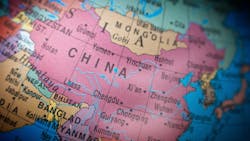Most children know what it means to have a face off. They usually involve two people wanting to establish themselves as the “top dog” in a neighborhood. In these types of confrontations, there is usually very little room for compromise. Although some face offs end in stalemate, others are decided with a winner and a loser—the loser being the one who blinks.
In my July 26 recap, I cited an article describing how Chinese manufacturing has been severely damaged by our tariffs on our imports of their products. I also pointed out, though, that those same tariffs are starting to result in quantifiable damage to U.S. manufacturing, although nowhere near the negative impact they are having on China’s economy.
I like to characterize our confrontation with China as a “biggest kid on the block”-type issue where what’s at stake is nothing less than positioning one or the other country to have predominance in influencing the standards of international trade. At issue is the U.S. pressuring China to significantly change their current trade practices while, at the same time, China is strongly resisting that pressure.
The point here at is that there are only a few possible outcomes to the current trade war, namely:
- China will blink. This seems unlikely since, as a Communist state, even though Chinese factories and employees are being negatively impacted, there will be less internal pressure on the government to back down.
- The U.S. will blink. This also seems unlikely as the current administration has invested a significant part of its political capital in its tariff policy.
- There is no agreement; i.e., U.S. tariffs on China are expanded and China resorts to “tit-for-tat” retaliation.
- There is a face-saving agreement involving incremental changes (again, as defined in my July 26 recap) to how China practices trade where both parties can claim some level of victory. Call me a skeptic, but I see this as the likeliest outcome.
From my seat in the ballpark, incremental changes such as committing to buy more U.S. soybeans (again!) or to stop manipulating their currency (again!) are just more of the same in a different wrapper, so I hope that our country can hold out so that we get the biggest benefit possible from this action that admittedly is starting to hurt our economy. If all the U.S. achieves with the tariffs is forcing incremental change, then I believe the whole point of the tariffs in the first place will not have been met.
After a while, incremental commitments usually fall under the radar and then can be walked back, as least as the Chinese are concerned. Step-function changes get more visibility and no-one can really back out of them without people noticing and/or reacting. Anyway, China has agreed to incremental changes in the past; we've touted our successful negotiations with them, and then later the situation moves towards what was the status quo prior to the agreements.
The following are two articles that elaborate on the pain both sides are facing.
China’s Pain
The August 5 article Japan Joins Exodus from China’s Factories as Tariffs Bite indicates that the impact of the U.S. tariff on China’s manufacturing are starting to take hold. According to the article, those included in looking to relocate include such huge Japanese corporations include Sony Corp., Ricoh Co. and Asics Corp. In doing so they aim to avoid tariffs on product going to one of their primary customers worldwide, the United States. China’s worry would be that these moves represent the first indication of a tidal wave of Japanese companies considering similar actions. Japan was one of the first countries to take advantage of low Chinese wages, and any indication that they are starting to transition their manufacturing out of that country has to be troubling to Chinese officials.
As an example, the article cites Ricoh, which got over a quarter of its 2018 revenue from the Americas and transferred production of high-speed printers in July from China to Thailand.
Paul Ericksen's columns are part of IndustryWeek's Supply Chain Initiative.
The August 1 article Steelmaker That Praised Trump Tariffs Now Suing US for Relief leaves me a bit confused. It describes how the U.S. Department of Commerce denied JSW tariff waivers for the steel-slab raw materials imported from India and Mexico to its steel plants in the U.S.
JSW Steel Ltd. is an Indian company with steel-producing plants around the world, including one in Texas and another in Ohio. According to the article, because of the denial, JSW’s two U.S.-based factories have had to spend tens of millions of dollars in tariffs. JSW says it needs to import steel slab because present U.S. capacity can’t produce the raw material in sufficient quantity.
JSW had plans in October 2018 to invest as much as $1 billion in its Baytown facility and hire 1,000 additional workers.
My confusion is related to what I had assumed was the whole point of steel tariffs in the first place, namely to increase the competitive value of U.S.-produced steel in the U.S. market—and, as a result, encourage investment in this country’s steel industry and thus create jobs. It looks like JSW is doing just that. If, indeed, U.S.-based steel-slab producers can’t presently support the demand from our country’s steel producers, it seems like denying the waiver is counterproductive.
China’s Nuclear Option?
The August 2 article China’s Trump Trade Retaliation Options Include Soybeans, Boeing lays out potential areas where China may hold leverage over the U.S. If taken as a whole, retaliatory moves in these areas represent a “nuclear option,” which I think is very unlikely because China is heavily invested not only in U.S. debt but in assets around the world. Because of this, they are unlikely to take action that will significantly reduce the value of these investments. On the other hand, the article does a good job of summarizing these areas, making it a good read for anyone interesting in understanding risks associated with our current tariff strategy.
Paul Ericksen is IndustryWeek’s supply chain advisor. He has 38 years of experience in industry, primarily in supply management at two large original equipment manufacturers.
About the Author

Paul Ericksen
Executive Level Consultant; IndustryWeek Supply Chain Advisor
Paul D. Ericksen has 40 years of experience in industry, primarily in supply management at two large original equipment manufacturers. At the second he was chief procurement officer. He then went on to head up a large multi-year supply chain flexibility initiative funded by the U.S. Department of Defense. He presently is an executive level consultant in both manufacturing and supply chain, counting Fortune 100 companies among his clientele. His articles on supply management issues have been published in Industrial Engineering, APICS, Purchasing Today, Target and other periodicals.
